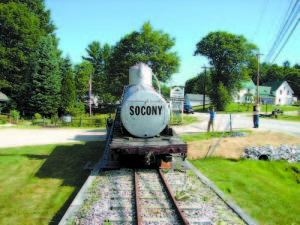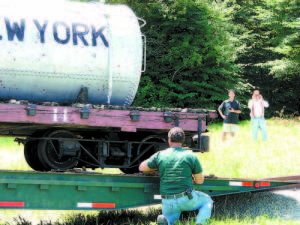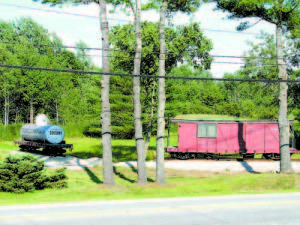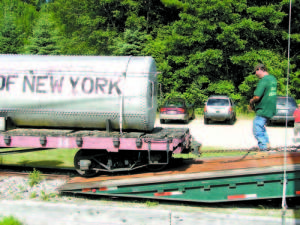News & Comment: Farewell to the Rails
Special to The News
The ghosts have exited, stage left. For now.
The latest five-year effort to bring a working narrow gauge train back to Bridgton came to a close last Friday, when the Return of the Rails’ display in front of the Greater Bridgton Lakes Region Chamber of Commerce building returned the two small railroad cars to their stewards, the Maine Narrow Gauge Railroad Co. of Portland.
The idea of establishing a museum on Depot Street and maybe developing a working tourist train was some time ago passed on to the Town of Gray, which convinced the Portland company that it had the most viable location and plan for a satellite narrow gauge railway museum.
Train museums and displays have long been part of the tourist attraction packages at Belfast, Boothbay, Phillips and Wiscasset. There is also a popular trolley museum in Kennebunkport. Since Bridgton — for almost 60 years — did have a working line and Gray, for example, never was rail-connected, it made sense to many in the area to try to bring the narrow gauge “back home.†Railroad aficionado Bill Shelley, of Bridgton and Georgia, even pledged his own money in matching funds through Return of the Rails, and led the effort to build the track for the Chamber display and other projects. But, the timing of fundraising and approvals couldn’t be made to mesh. Still, Shelley appeared in parades with his mounted train whistle — and often didn’t even wait for a parade to blow the horn on his “ghost train.â€
 The idea of using of the old school lot (and depot yard) at the end of Depot Street, and running a short track across town land and on the old right-of-way through town, received support, including from the Historical Society and some town officials. But, legal questions and some local resistance to the proposed project eventually ran the string out on a viable Bridgton plan. Even 70 years after the trains were sold off, factions of enthusiasts for the trains still remained committed, saying the trains never should have left “in the first place.†Others insisted it was wise to sell then, and it still seems for the best, and anyway, the latest plan required more unanimous public support and required more legal groundwork.
The idea of using of the old school lot (and depot yard) at the end of Depot Street, and running a short track across town land and on the old right-of-way through town, received support, including from the Historical Society and some town officials. But, legal questions and some local resistance to the proposed project eventually ran the string out on a viable Bridgton plan. Even 70 years after the trains were sold off, factions of enthusiasts for the trains still remained committed, saying the trains never should have left “in the first place.†Others insisted it was wise to sell then, and it still seems for the best, and anyway, the latest plan required more unanimous public support and required more legal groundwork.
Anyway, time’s up. That push is over. I was one who had no particular interest in trains, but I do love history, and Bridgton, and the idea just seemed like a natural fit to me, the kind of project that would tie the planned present to the working, historic past and to the tourist-involved future. Every town needs something special and different to make it stand out. Further, towns need to understand that a living past keeps them vibrant, tells them who they are, and reminds them that all they see around them today did not just happen — somebody made it all happen.
Bridgton already has a lot going for it, of course, including its fairly well-preserved downtown, its visible history, strong tourist support systems and, of course, the Mountain and the beautiful lakes. It seemed to me that bringing the train back would just complete the package, and make the Bridgton brand truly different in Maine, providing a unique combination of historic and scenic effects — but I understand too that there were difficulties, and lots of Ts to cross, and no way to guarantee success. Also, competing ideas were presented, of course, both on the local front and from the outside, as well, in the form of bids by other towns for a satellite working narrow gauge museum.
I think Bill Shelley and his Return of the Rails group deserve kudos for trying, and for all the work they did do, and while that group has now no real local project to support, maybe something will be done by the next generation? Or by this one — if the Gray project falters. Because, guess what — this old equipment lasts forever. Even the jury-rigged cars were built to last, and they have lasted. The tracks are long gone, but the right-of-way through woods and fields remains hard-packed and clearly visible for more than 20 miles through this section of Maine southward.
 Many of the cars in stock at the narrow gauge museum at Portland originally ran as part of the Bridgton & Saco River RR, a narrow gauge line connecting Bridgton, Sandy Creek, Sebago, Denmark and Hiram to the standard gauge track running from Portland to points northwest. The cars displayed in front of the Chamber ran on that line, which eventually was extended to Harrison, and carried freight and passengers on regular schedules.
Many of the cars in stock at the narrow gauge museum at Portland originally ran as part of the Bridgton & Saco River RR, a narrow gauge line connecting Bridgton, Sandy Creek, Sebago, Denmark and Hiram to the standard gauge track running from Portland to points northwest. The cars displayed in front of the Chamber ran on that line, which eventually was extended to Harrison, and carried freight and passengers on regular schedules.
The railroad era almost literally put Bridgton back on the map, lasting under its best head of steam from the 1880s to the 1920s, with the little trains superseding the transportation options of the canals and lake traffic. A living example of that long-gone lake traffic is Naples’ famous Songo River Queen line. But the little trains were themselves later overtaken by trucks trundling on the highways, and finally the railroad equipment was sold off lock, stock and socket wrench to a Massachusetts entrepreneur. Then, 20 years ago, that same equipment, some of it “busted but still running,†as an old book title said (underlining the spunkiness of the original Bridgton line), arrived in Portland for display and to eventually provide rides for families around the perimeter of the Portland waterfront. Equipment from other Maine lines is used and displayed there as well, with a cadre of volunteers spending their own time and money to repair, refurbish and run the old equipment. (They are tireless, those volunteers; there is no fan quite as fanatic as a railfan.) If you’ve never taken your family to the Portland museum, you will find that kids love train rides — especially when the cars seem almost fashioned to their scale!
Other “ghost trains†besides Shelley’s ghostly whistle have been seen and heard in the area in the past few years. The old “Pondicherry†railcar and engine ran on a very short section of track set up in Bolster’s Mills, with work coordinated by the unsinkable Gerry Smith of Harrison — but that was a short and temporary arrangement. The Portland corporation loaned several different cars to Bridgton, to help promote the Return of the Rails effort. Shelley and a small crew built the few feet of track that the cars sat on. Local businesses supported the project, and the cost and time involved in hauling the cars up and back on Route 302 was donated, as well.
 The Chamber says it will landscape the area and do something different now that the cars have pulled out of town; maybe another garden will go in. Some other reminder of local history would work, too. But, no, no trains. No trains for Bridgton. It wasn’t really all that easy to even get the cars here. An opportunity missed.
The Chamber says it will landscape the area and do something different now that the cars have pulled out of town; maybe another garden will go in. Some other reminder of local history would work, too. But, no, no trains. No trains for Bridgton. It wasn’t really all that easy to even get the cars here. An opportunity missed.
There are trains in Bridgton, it should be noted. The local Historical Society on Gibbs Avenue has a terrific display with artifacts like lanterns and tickets and tons of pictures, all from “The Dinky,†which some old-timers can remember riding up through to Bridgton-on-the-Lakes.
Photos courtesy of Bill Shelley. The final photo shows the two rail cars at the site of a future railroad museum in Gray off Route 100.


